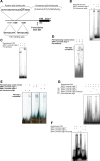A single-nucleotide variation in a p53-binding site affects nutrient-sensitive human SIRT1 expression
- PMID: 20693263
- PMCID: PMC2951863
- DOI: 10.1093/hmg/ddq331
A single-nucleotide variation in a p53-binding site affects nutrient-sensitive human SIRT1 expression
Abstract
The SIRTUIN1 (SIRT1) deacetylase responds to changes in nutrient availability and regulates mammalian physiology and metabolism. Human and mouse SIRT1 are transcriptionally repressed by p53 via p53 response elements in their proximal promoters. Here, we identify a novel p53-binding sequence in the distal human SIRT1 promoter that is required for nutrient-sensitive SIRT1 transcription. In addition, we show that a common single-nucleotide (C/T) variation in this sequence affects nutrient deprivation-induced SIRT1 transcription, and calorie restriction-induced SIRT1 expression. The p53-binding sequence lies in a region of the SIRT1 promoter that also binds the transcriptional repressor Hypermethylated-In-Cancer-1 (HIC1). Nutrient deprivation increases occupancy by p53, while decreasing occupancy by HIC1, of this region of the promoter. HIC1 and p53 compete with each other for promoter occupancy. In comparison with the T variation, the C variation disrupts the mirror image symmetry of the p53-binding sequence, resulting in decreased binding to p53, decreased nutrient sensitivity of the promoter and impaired calorie restriction-stimulated tissue expression of SIRT1 and SIRT1 target genes AMPKα2 and PGC-1β. Thus, a common SNP in a novel p53-binding sequence in the human SIRT1 promoter affects nutrient-sensitive SIRT1 expression, and could have a significant impact on calorie restriction-induced, SIRT1-mediated, changes in human metabolism and physiology.
Figures





Similar articles
-
Tumor suppressor HIC1 directly regulates SIRT1 to modulate p53-dependent DNA-damage responses.Cell. 2005 Nov 4;123(3):437-48. doi: 10.1016/j.cell.2005.08.011. Cell. 2005. PMID: 16269335
-
Serum withdrawal up-regulates human SIRT1 gene expression in a p53-dependent manner.J Cell Mol Med. 2009 Oct;13(10):4176-84. doi: 10.1111/j.1582-4934.2008.00468.x. J Cell Mol Med. 2009. PMID: 19267881 Free PMC article.
-
Regulation of SIRT1 protein levels by nutrient availability.FEBS Lett. 2008 Jul 9;582(16):2417-23. doi: 10.1016/j.febslet.2008.06.005. Epub 2008 Jun 9. FEBS Lett. 2008. PMID: 18544345
-
Role of Sirtuin1-p53 regulatory axis in aging, cancer and cellular reprogramming.Ageing Res Rev. 2018 May;43:64-80. doi: 10.1016/j.arr.2018.02.004. Epub 2018 Feb 21. Ageing Res Rev. 2018. PMID: 29476819 Review.
-
Sirtuin1-p53: A potential axis for cancer therapy.Biochem Pharmacol. 2023 Jun;212:115543. doi: 10.1016/j.bcp.2023.115543. Epub 2023 Apr 8. Biochem Pharmacol. 2023. PMID: 37037265 Review.
Cited by
-
SIRT1 regulation modulates stroke outcome.Transl Stroke Res. 2013 Dec;4(6):663-71. doi: 10.1007/s12975-013-0277-y. Epub 2013 Aug 15. Transl Stroke Res. 2013. PMID: 24323420 Review.
-
Metabolic functions of the tumor suppressor p53: Implications in normal physiology, metabolic disorders, and cancer.Mol Metab. 2020 Mar;33:2-22. doi: 10.1016/j.molmet.2019.10.002. Epub 2019 Oct 18. Mol Metab. 2020. PMID: 31685430 Free PMC article. Review.
-
Genetic Variants of SIRT1 Gene Promoter in Type 2 Diabetes.Int J Endocrinol. 2023 Jan 28;2023:6919275. doi: 10.1155/2023/6919275. eCollection 2023. Int J Endocrinol. 2023. PMID: 36747995 Free PMC article.
-
SIRT1 gene polymorphisms and risk of lung cancer.Cancer Manag Res. 2017 Sep 4;9:381-386. doi: 10.2147/CMAR.S142677. eCollection 2017. Cancer Manag Res. 2017. PMID: 28919817 Free PMC article.
-
Gene Polymorphisms Associated with Central Precocious Puberty and Hormone Levels in Chinese Girls.Int J Endocrinol. 2022 Aug 21;2022:9450663. doi: 10.1155/2022/9450663. eCollection 2022. Int J Endocrinol. 2022. PMID: 36046800 Free PMC article.
References
-
- Kaeberlein M., McVey M., Guarente L. The SIR2/3/4 complex and SIR2 alone promote longevity in Saccharomyces cerevisiae by two different mechanisms. Genes Dev. 1999;13:2570–2580. doi:10.1101/gad.13.19.2570. - DOI - PMC - PubMed
-
- Boily G., Seifert E.L., Bevilacqua L., He X.H., Sabourin G., Estey C., Moffat C., Crawford S., Saliba S., Jardine K., et al. SirT1 regulates energy metabolism and response to caloric restriction in mice. PLoS ONE. 2008;3:e1759. doi:10.1371/journal.pone.0001759. - DOI - PMC - PubMed
-
- Rodgers J.T., Lerin C., Haas W., Gygi S.P., Spiegelman B.M., Puigserver P. Nutrient control of glucose homeostasis through a complex of PGC-1alpha and SIRT1. Nature. 2005;434:113–118. doi:10.1038/nature03354. - DOI - PubMed
-
- Picard F., Kurtev M., Chung N., Topark-Ngarm A., Senawong T., Machado De Oliveira R., Leid M., McBurney M.W., Guarente L. Sirt1 promotes fat mobilization in white adipocytes by repressing PPAR-gamma. Nature. 2004;429:771–776. doi:10.1038/nature02583. - DOI - PMC - PubMed
-
- Gerhart-Hines Z., Rodgers J.T., Bare O., Lerin C., Kim S.H., Mostoslavsky R., Alt F.W., Wu Z., Puigserver P. Metabolic control of muscle mitochondrial function and fatty acid oxidation through SIRT1/PGC-1alpha. EMBO J. 2007;26:1913–1923. doi:10.1038/sj.emboj.7601633. - DOI - PMC - PubMed
Publication types
MeSH terms
Substances
Grants and funding
LinkOut - more resources
Full Text Sources
Research Materials
Miscellaneous

